
- SAP Community
- Products and Technology
- Technology
- Technology Blogs by Members
- How to build the iOS App that displays SAP S/4HANA...
Technology Blogs by Members
Explore a vibrant mix of technical expertise, industry insights, and tech buzz in member blogs covering SAP products, technology, and events. Get in the mix!
Turn on suggestions
Auto-suggest helps you quickly narrow down your search results by suggesting possible matches as you type.
Showing results for
former_member48
Discoverer
Options
- Subscribe to RSS Feed
- Mark as New
- Mark as Read
- Bookmark
- Subscribe
- Printer Friendly Page
- Report Inappropriate Content
04-22-2019
7:47 AM
This is the continuation of the my previous post.
There are three steps, and that the first two steps can be read there .
I build the iOS app that displays SAP S/4HANA data as AR 3D object. I'd like to share detail steps I took.
Architecture

Procedure
1. Implement GetEntitySet method of OData on SAP S/4HANA
2. Generate an Xcode Project with SCP SDK for iOS Assistant
3. Implement the AR to generated Xcode Project on step2
This post is introduce Step 3.
Please refer to the previous article for Step1-2.
3. Implement AR with Xcode
In the previous article, an Xcode project connected to SAP S4HANA was automatically generated by the SCP SDK for iOS. This time, I will implement the AR function by updating the generated Xcode project.
Add a Storyboard
First, create a folder named "App" under the main directory of the project.
Resources to be newly implemented will be put in this folder.
Add a storyboard. Right-click on the App folder and select [New File] and add the storyboard named "MyStoryboard".
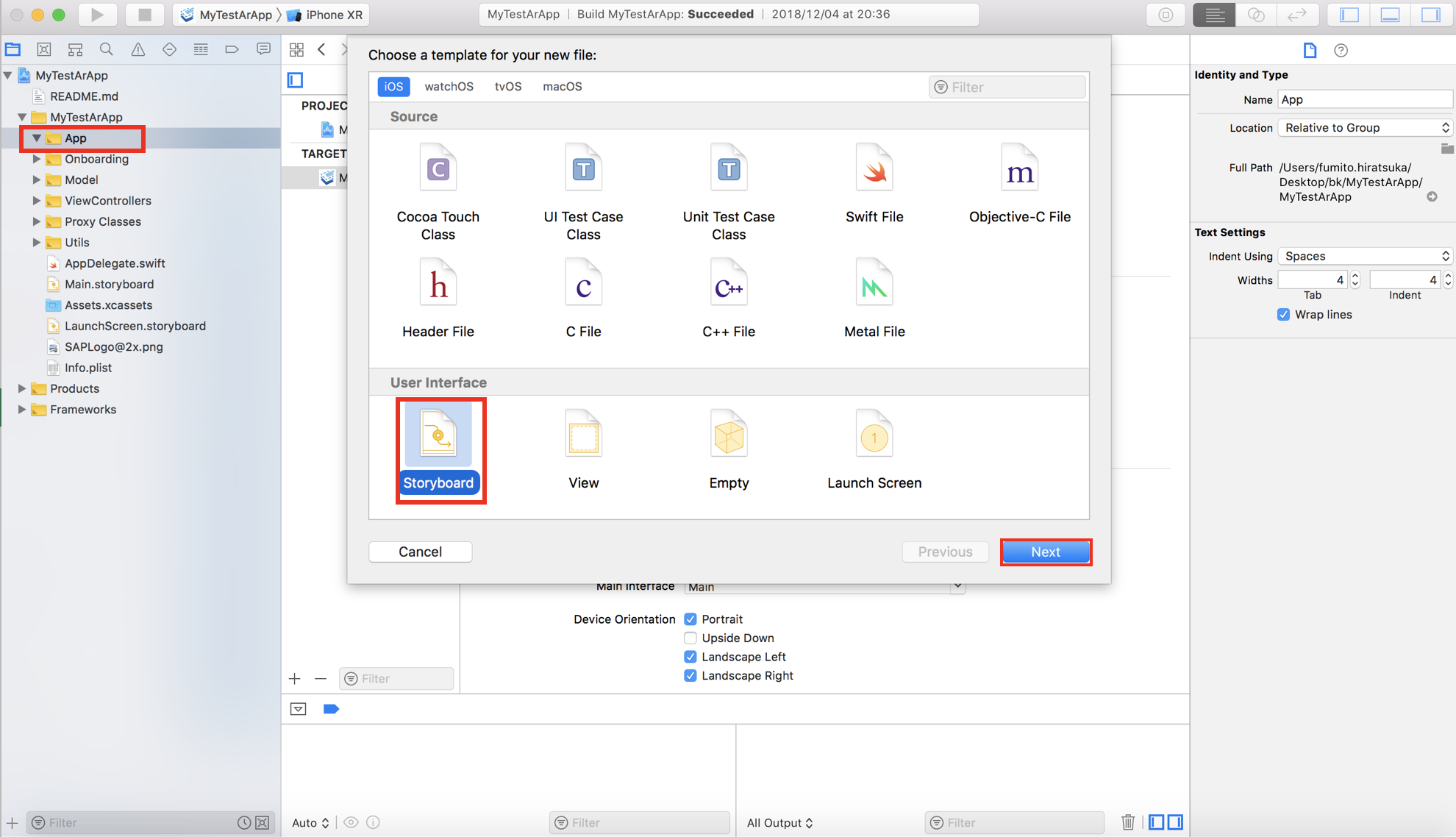
Click the upper right [Library] button and drag and place the view controller on the storyboard.
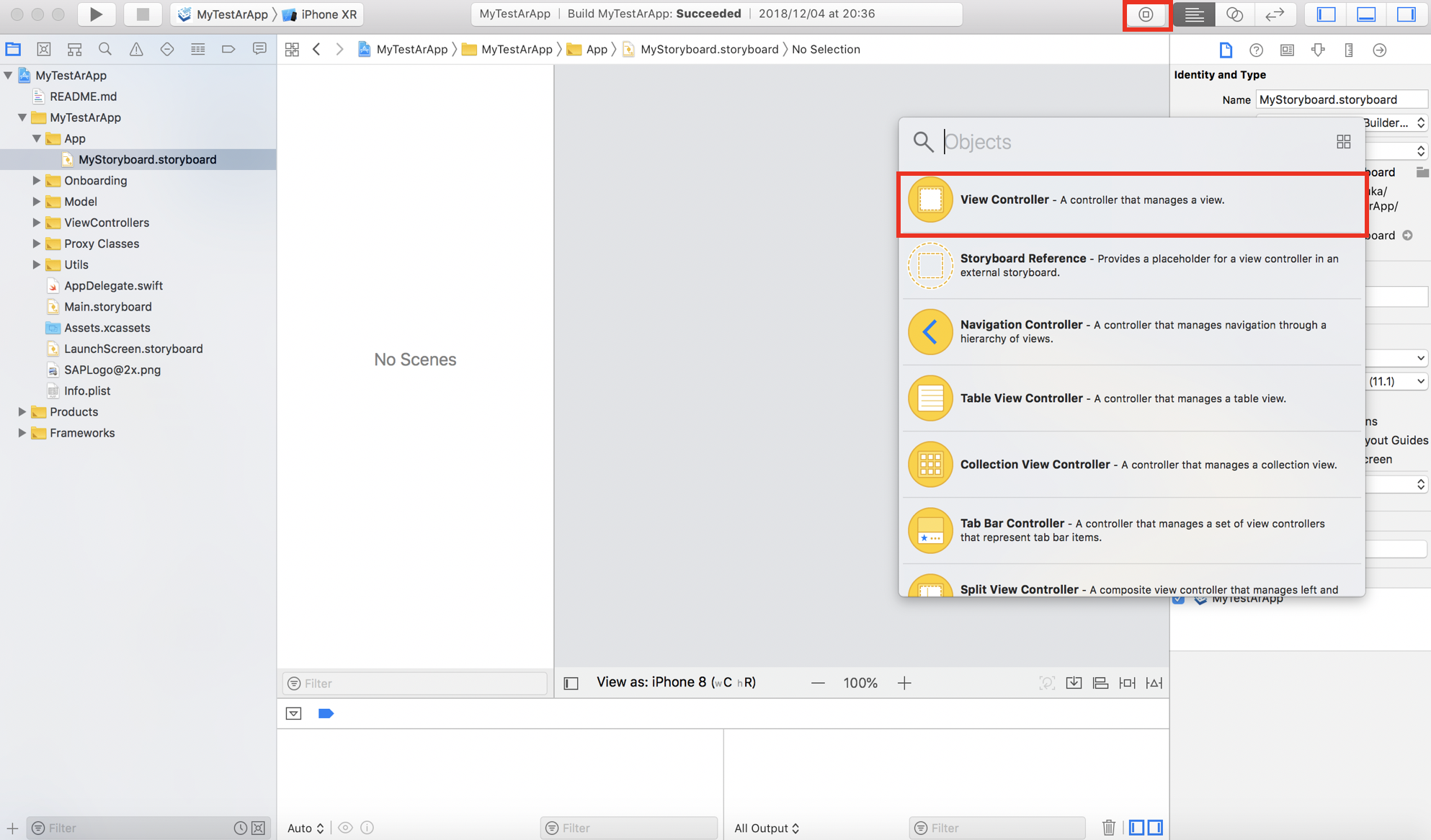
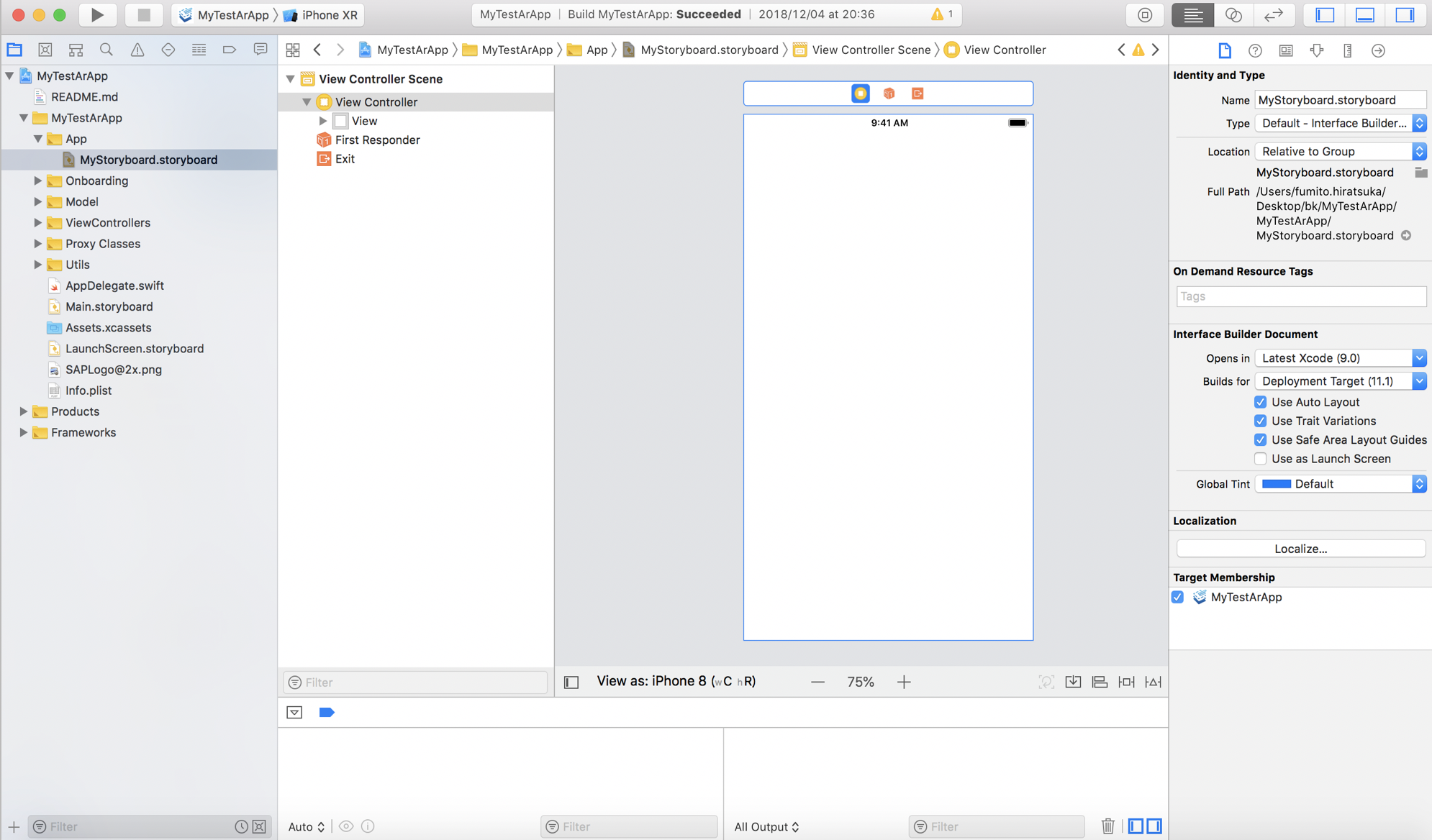
From the upper right [Library] button, drag [ARKit SceneKit View] on the view controller in the storyboard.
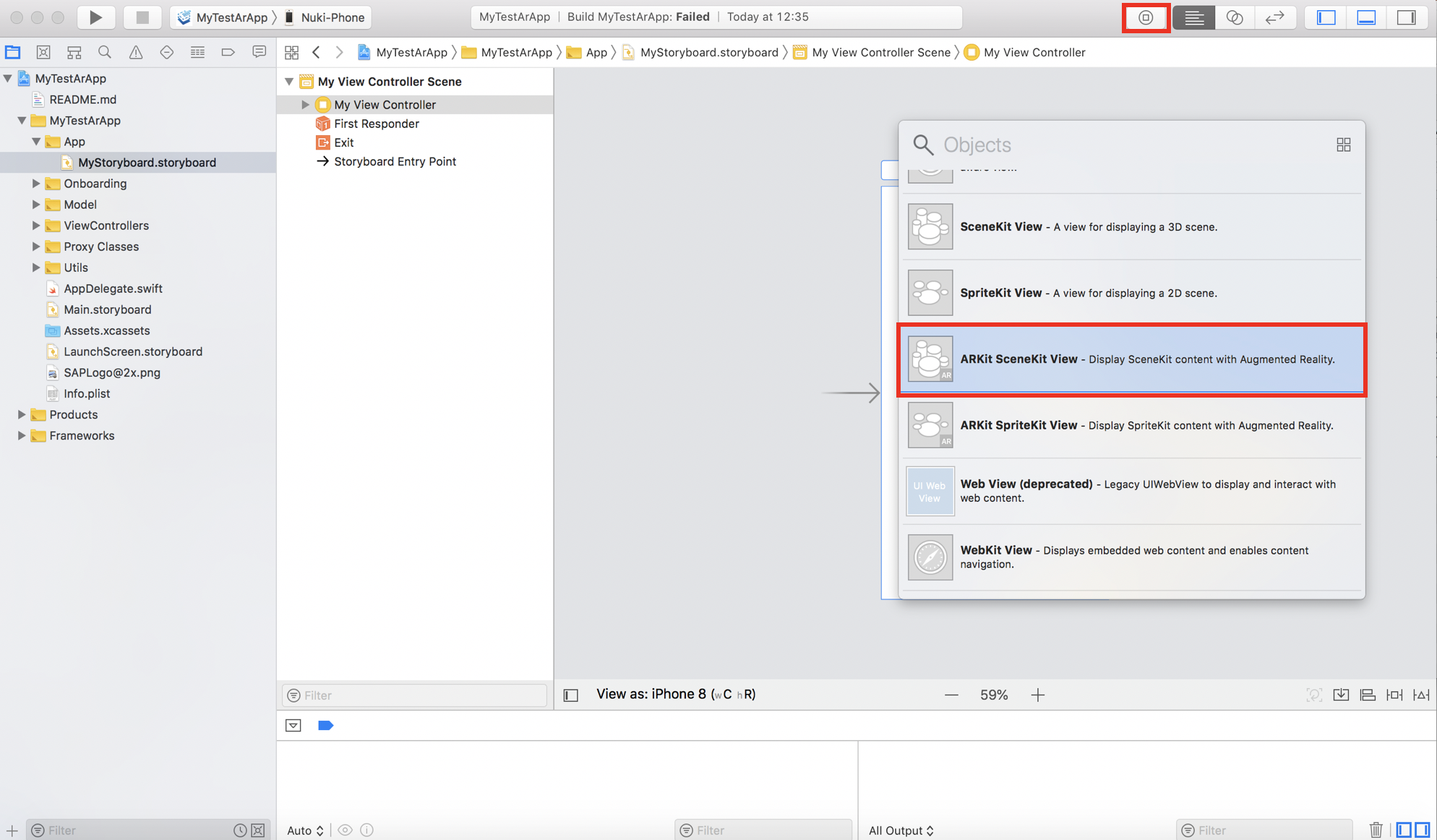
Expand the placed Scene View to the view controller. Next, add a Constraint from the bottom right button to prevent View shifting depending on the screen size of the device. Let's set the distance from the view controller to 0 and click [Add 4 Constraints].
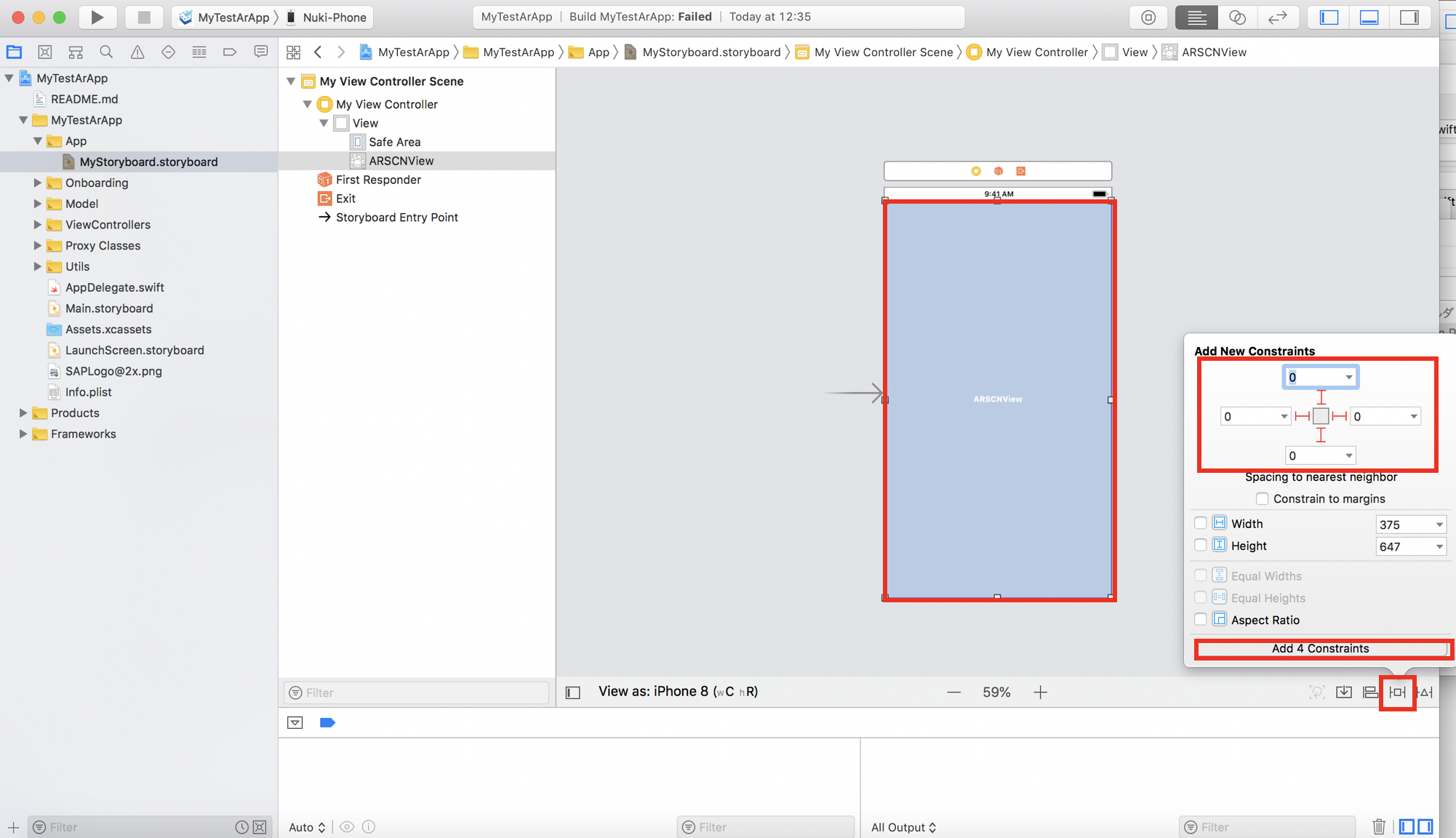
Add a Scene file
Right-click on the App folder, select [SpriteKit Scene] from [New File] and add it. In this case, I will name it "Scene.sks".
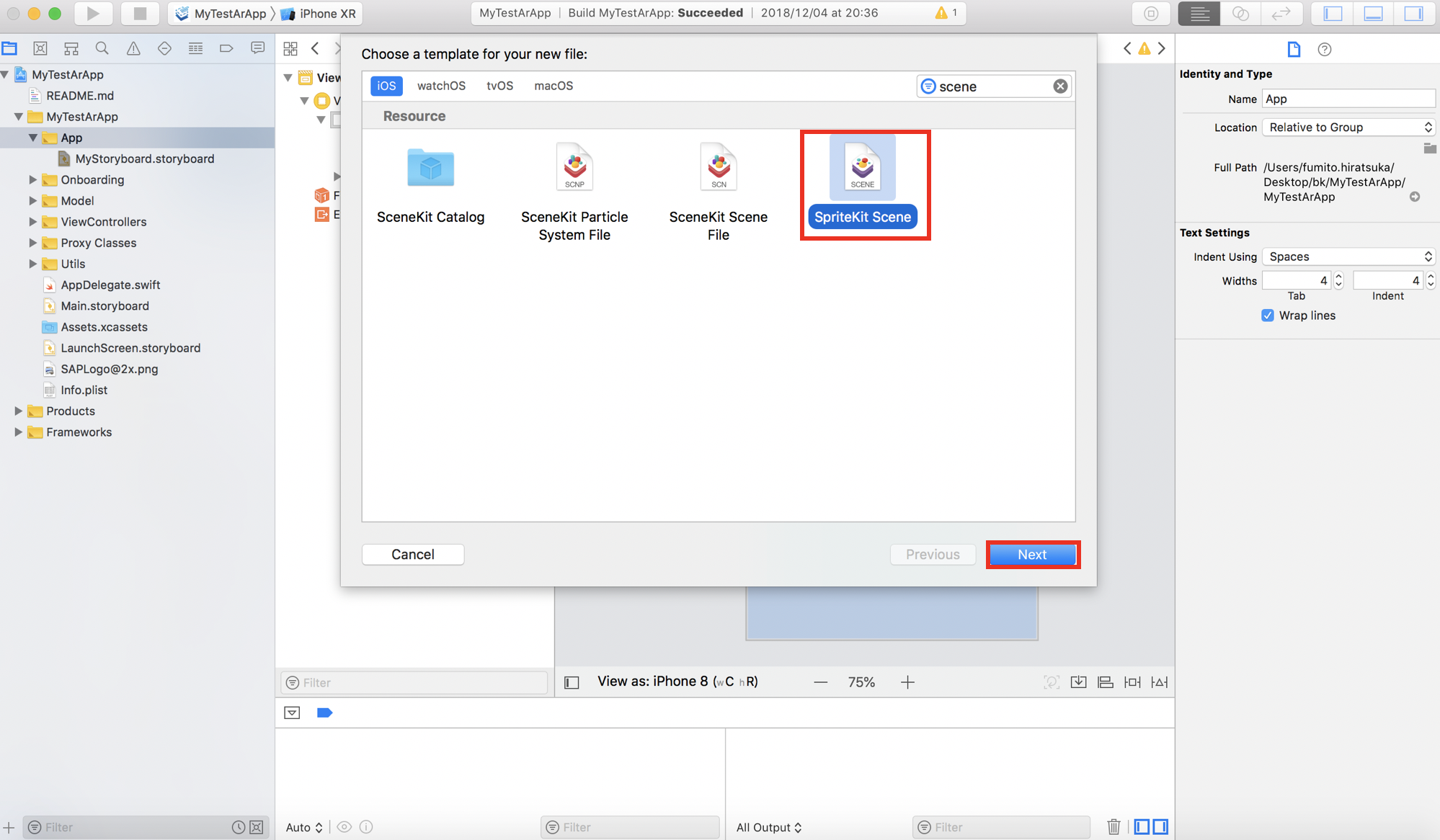
Add Swift file
Right-click on the App folder> select "New File"> "Cocoa Touch Class" to add it.

Enter the name "Scene" and select the class "SKScene".
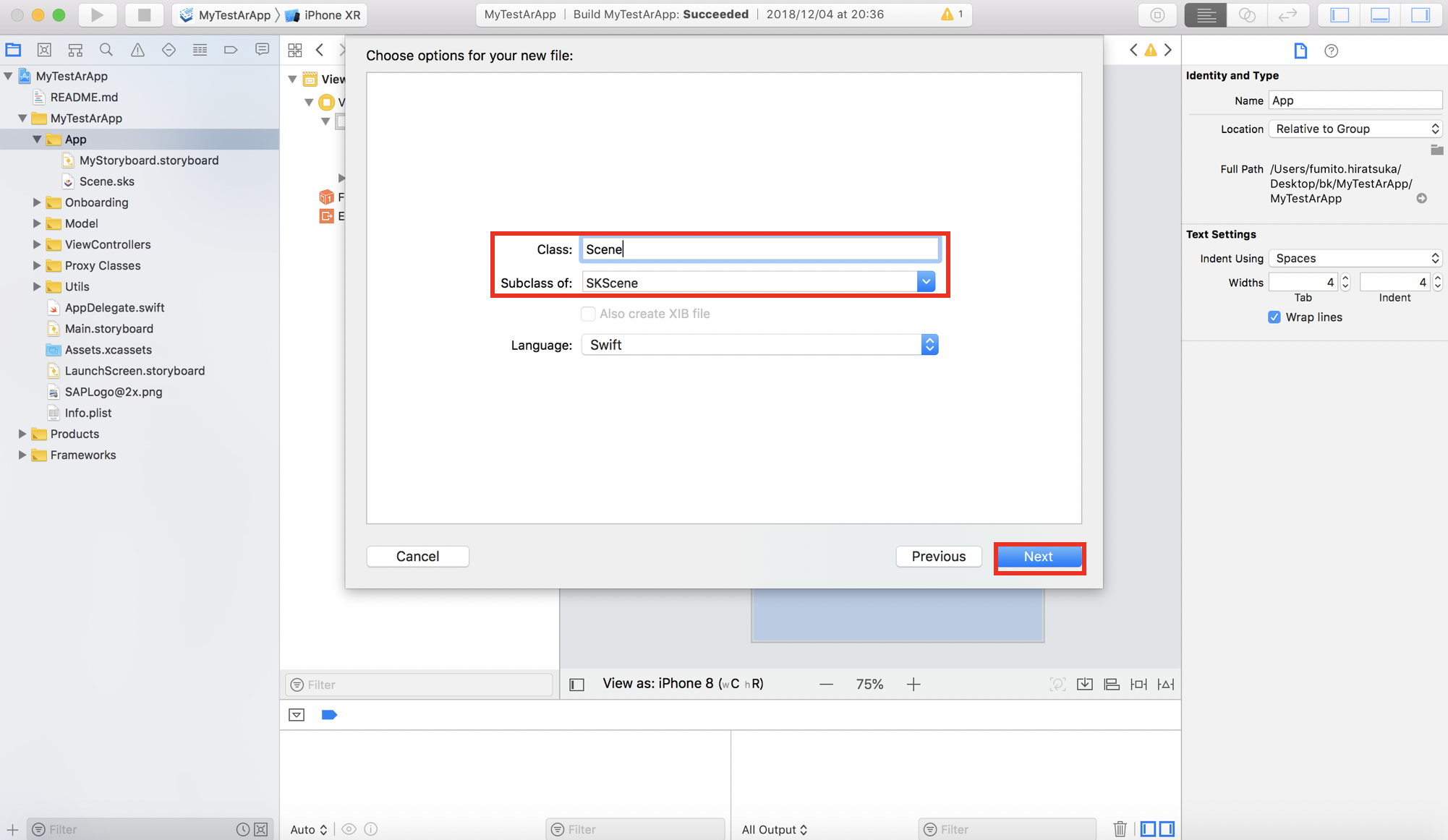
Next, add a Swift file for the view controller. Right-click on the App folder> select "New File"> "Cocoa Touch Class" to add it.
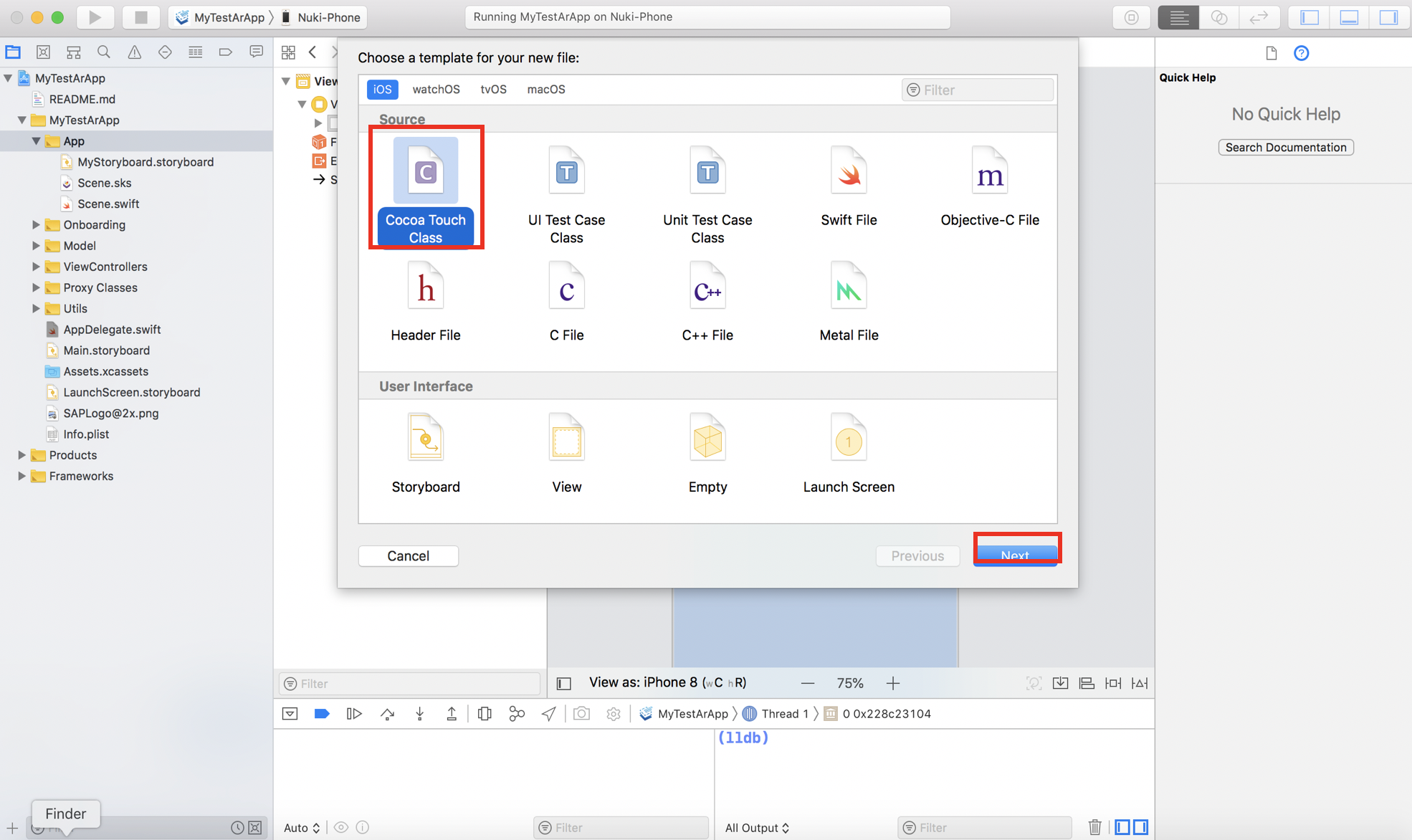
Enter the name MyViewController" and select the class "UIViewController".
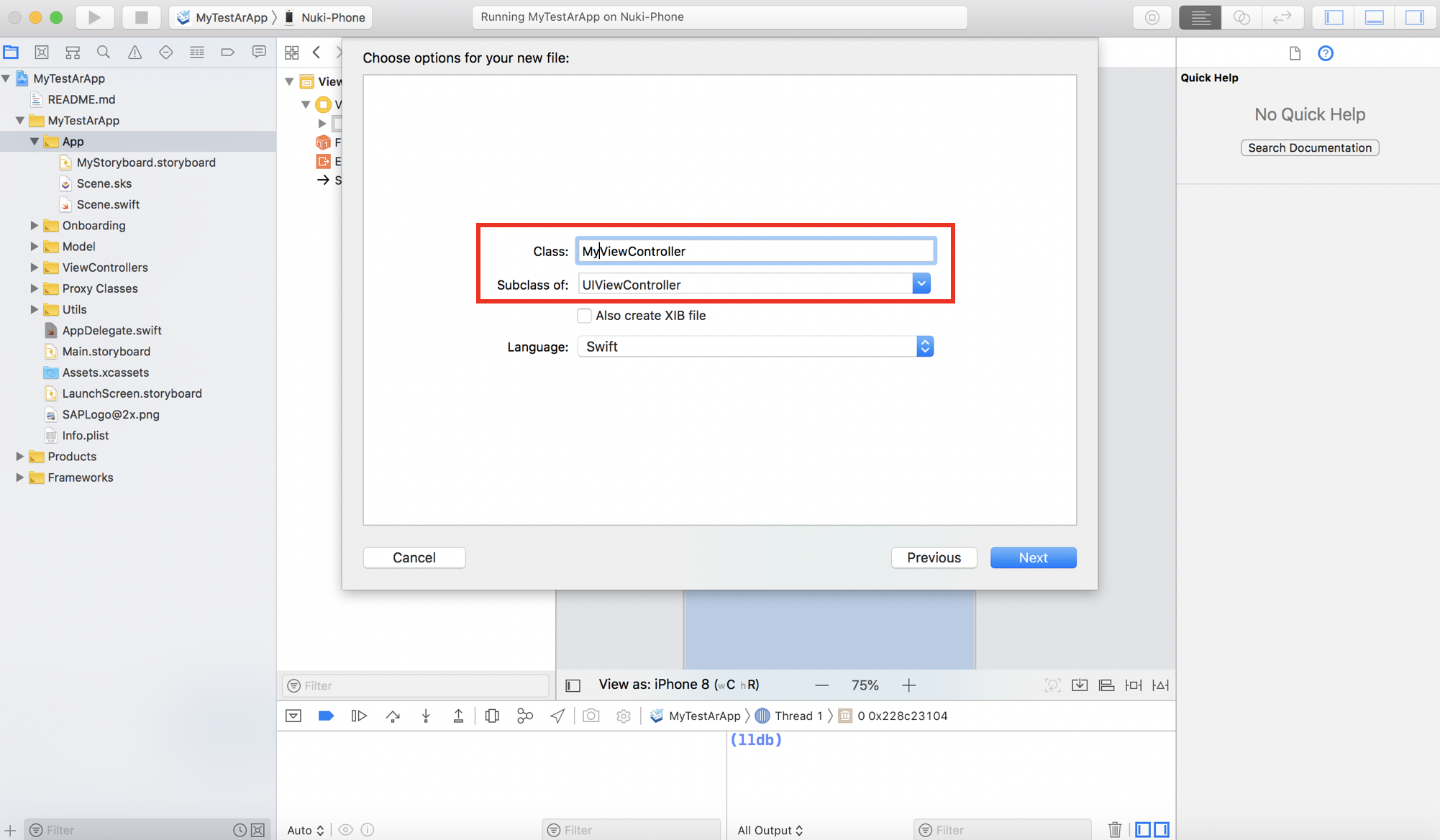
Select the class in Storyboard and link to view controller.
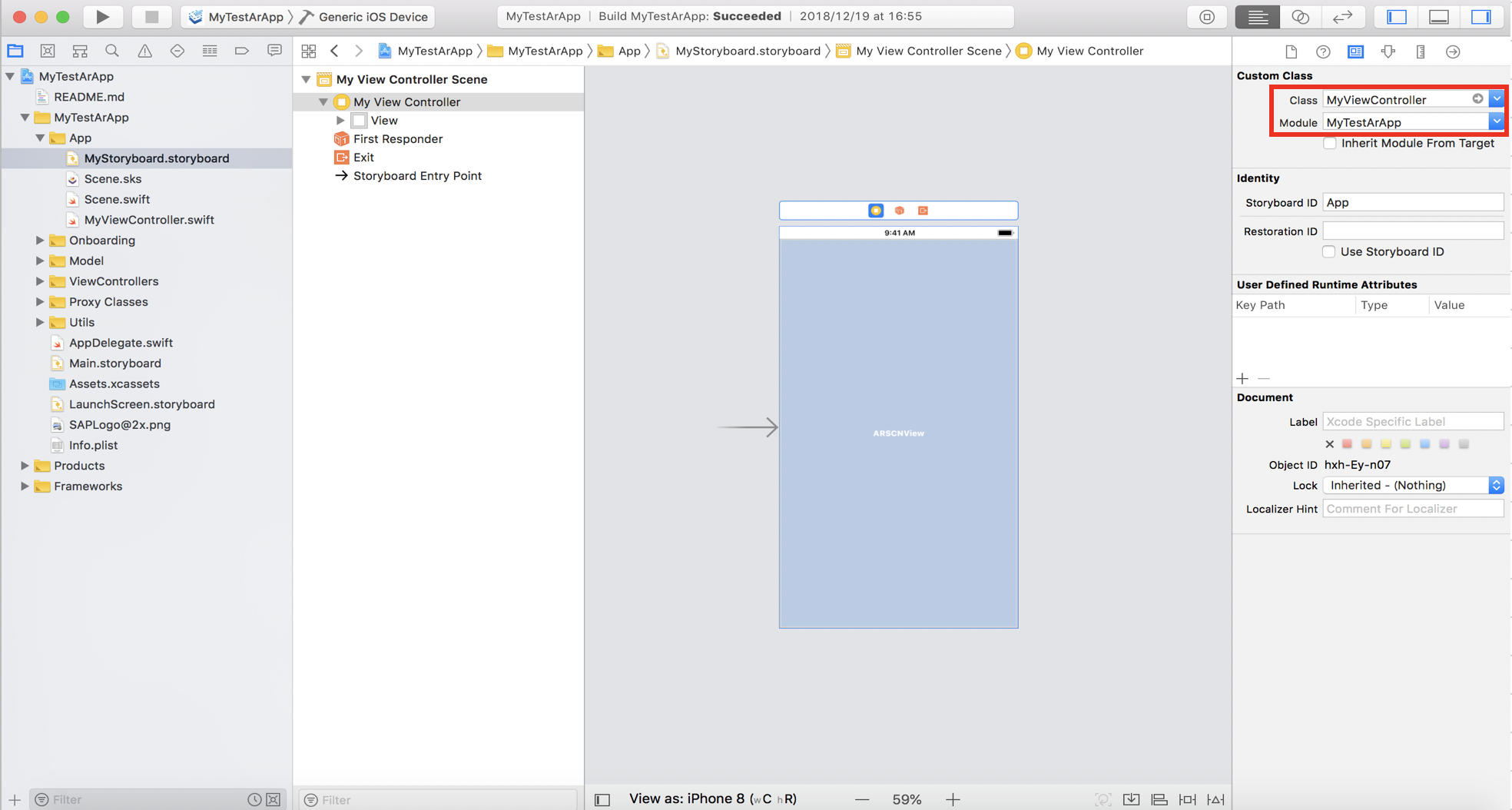
Prepare images
I will implement a action that places a 3D object in AR space when an image is detected by the camera using ARKit Recognizing Images.
First, prepare an image file. Place an image for the Recognizing Images in the Assets folder. Select [New AR Resource Group] from the [+] button to create a folder.
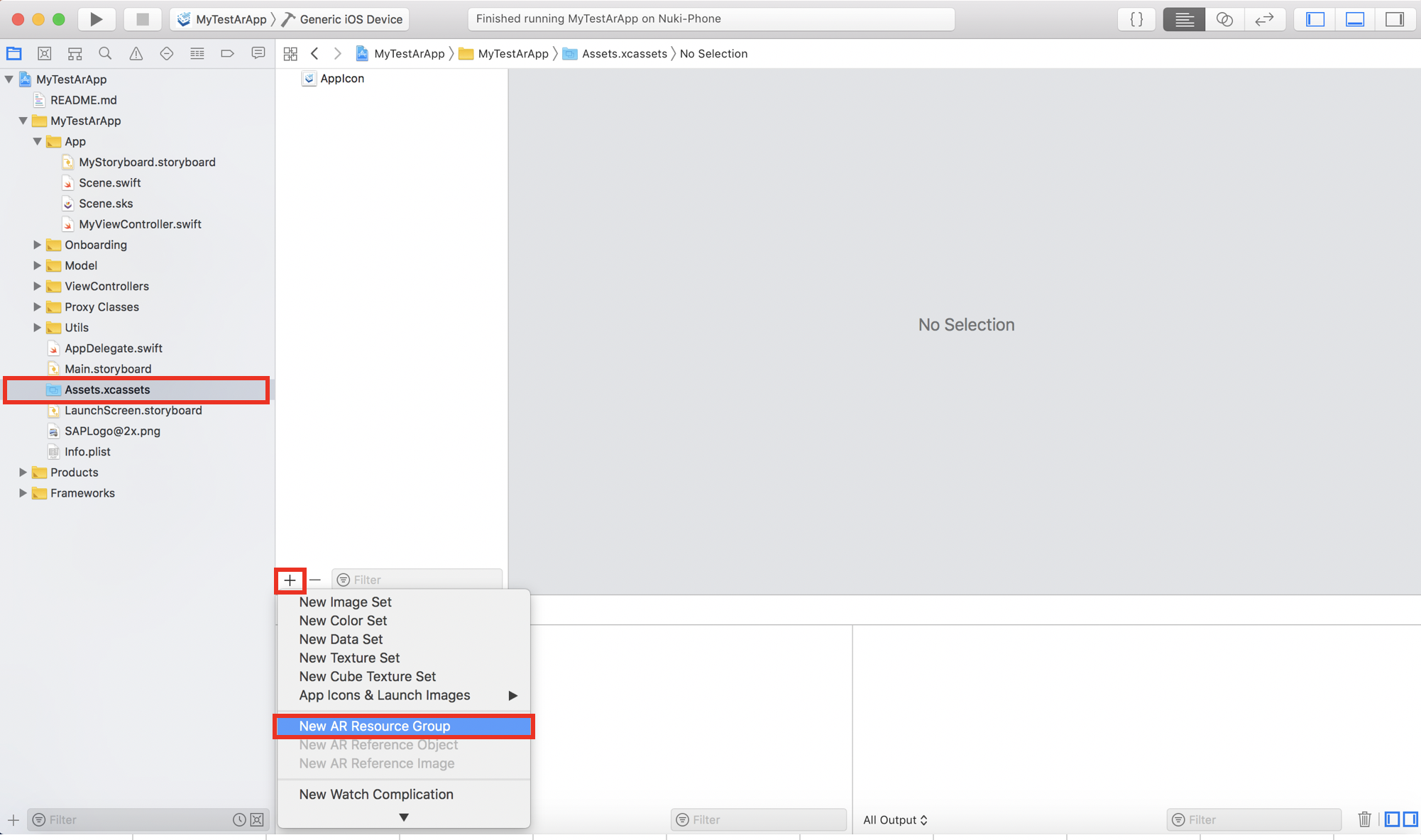
I set material codes on S/4HANA as image names for data linking. Also remember to set the actual size of the thing to be recognized.
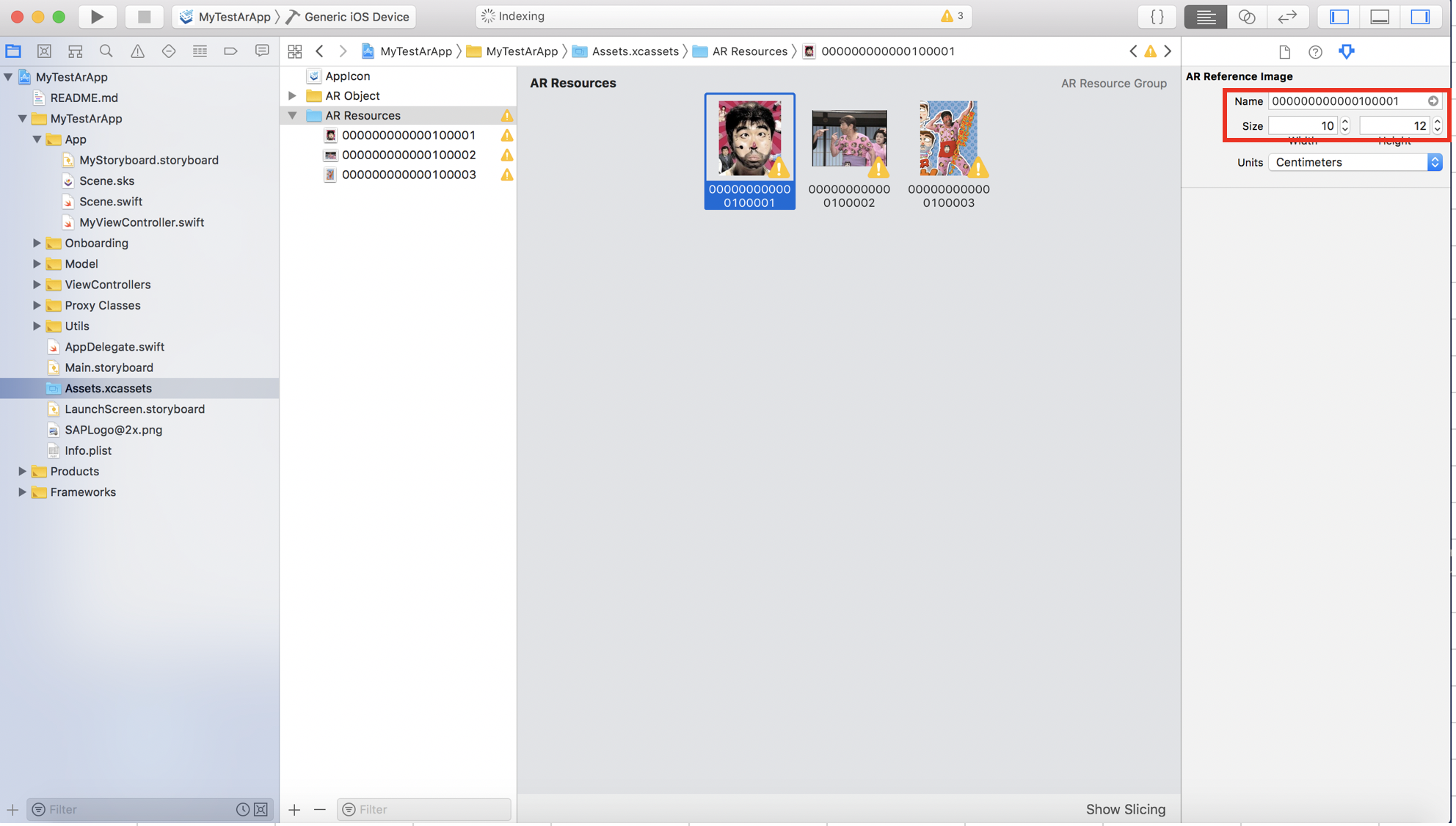
Update plist
In order to use the camera, set "Privacy-Camera Usage Description" in plist. It is displayed as a message when asking for permission of the camera when the app is launched for the first time. Without this description, the app will crash.
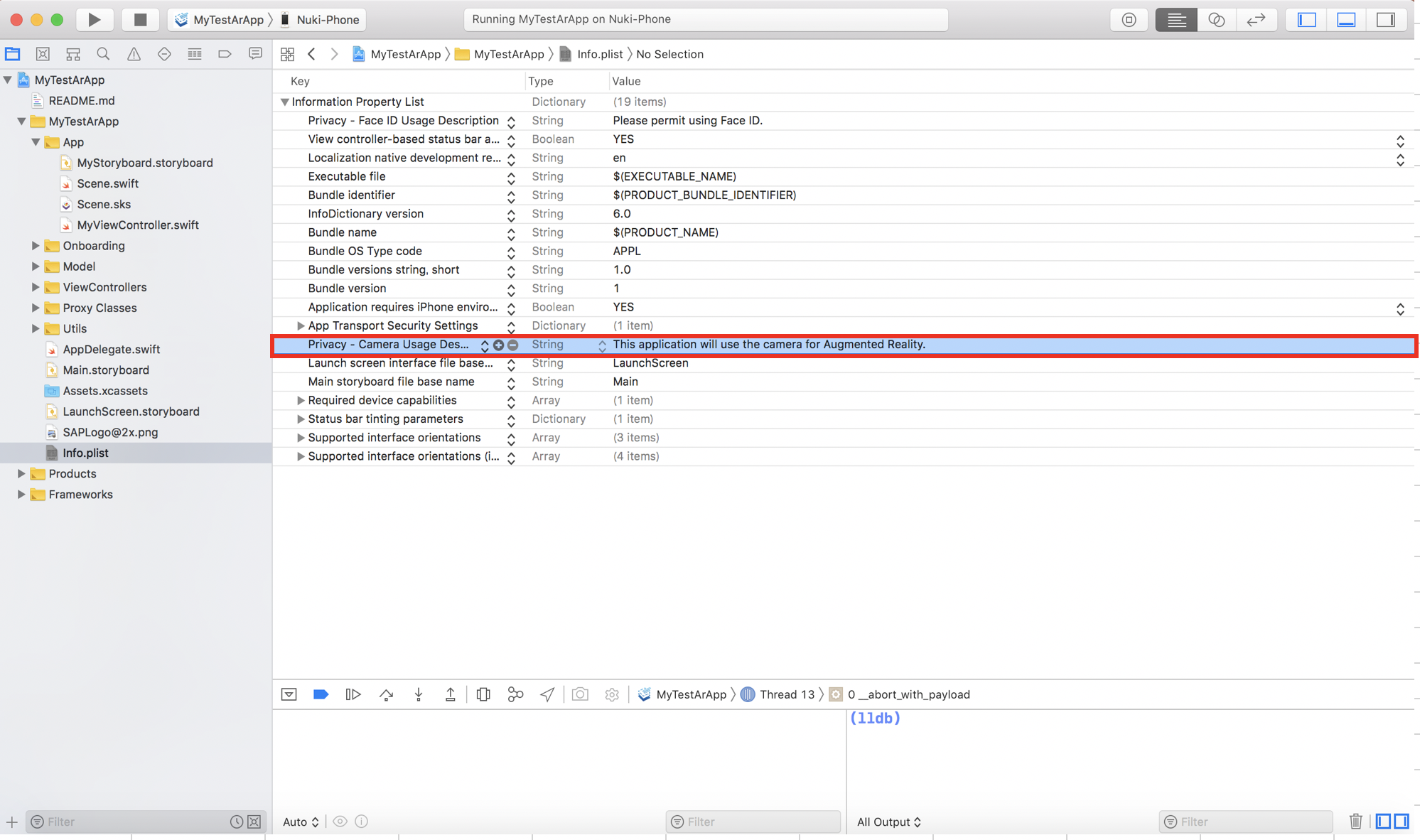
Change the initial Storyboard
At the default code, "Main.storyboard" is specified as the initial display, so change it to Storyboard I created this time.
Enter StoryboardID ("App") in the Identify information of the created view controller.
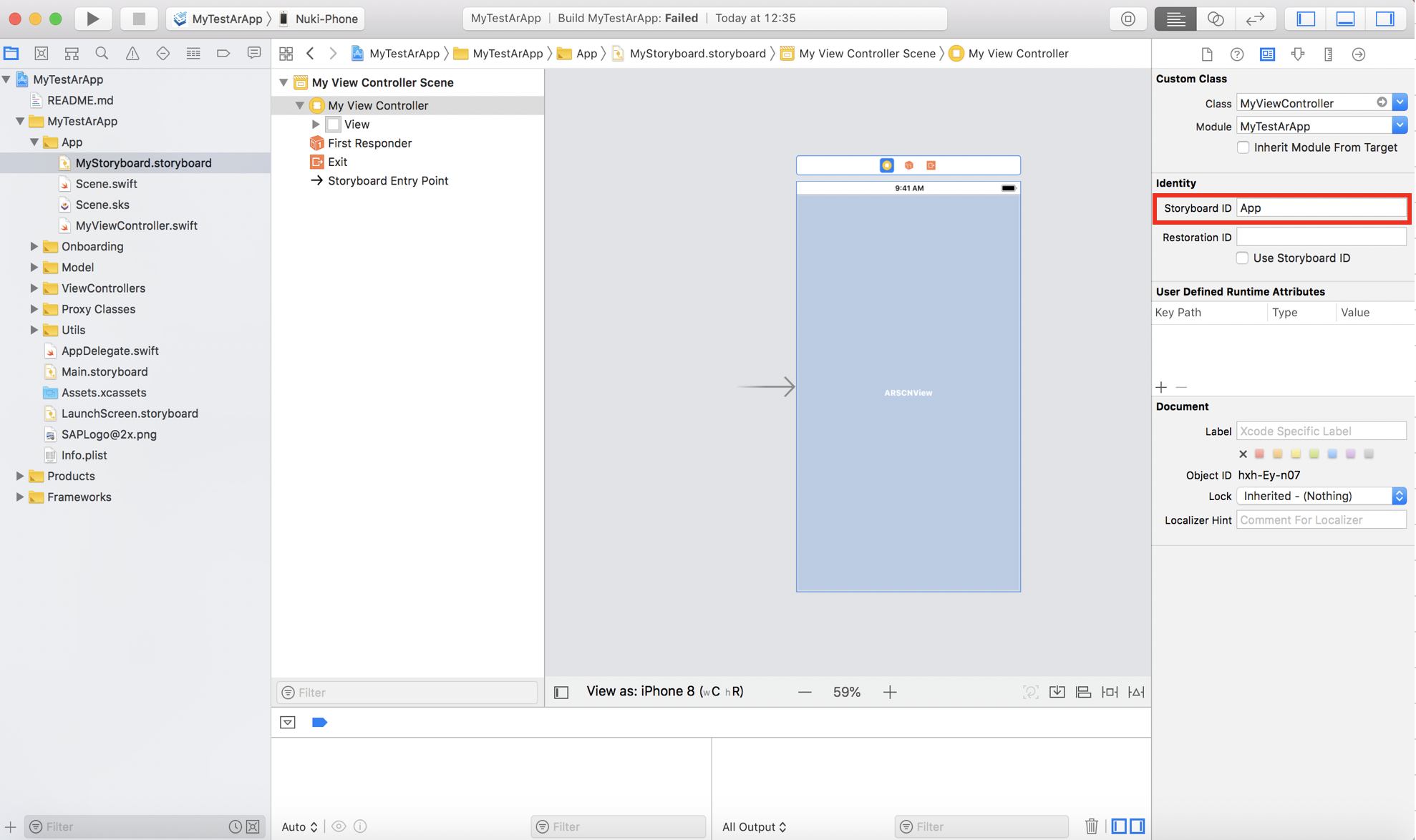
Next, modify AppDelegate.Swift. Modify the default code as below and specify the Storyboard I created.
AppDelegate.swift
private func setRootViewController() {
DispatchQueue.main.async {
//デフォルトコード→コメントアウト
//let splitViewController = UIStoryboard(name: "Main", bundle: Bundle.main).instantiateViewController(withIdentifier: "MainSplitViewController") as! UISplitViewController
//splitViewController.delegate = self
//splitViewController.modalPresentationStyle = .currentContext
//splitViewController.preferredDisplayMode = .allVisible
//今回作成したStoryboardを指定
let viewController = UIStoryboard(name: "MyStoryboard", bundle: Bundle.main).instantiateViewController(withIdentifier: "App")
self.window!.rootViewController = viewController
}
}
Implement session start method
I will implement the main view controller (MyViewController.swift).
First, make outlet connection of SceneView from Storyboard.
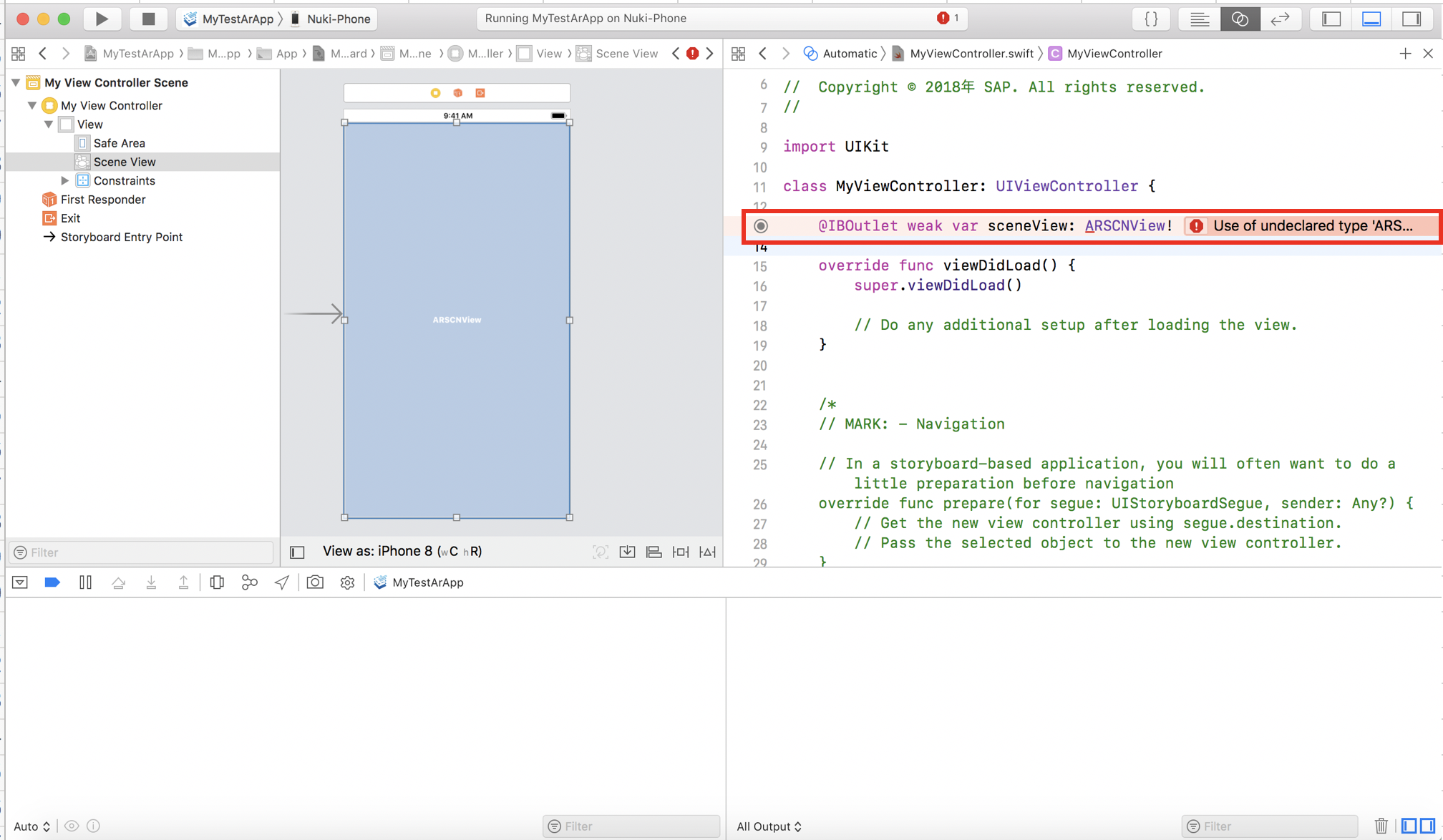
Import the framework used in this implementation.
MyViewController.swift
import ARKit
import SAPFiori
import SAPOData
Next, implement the startSession method.
MyViewController.swift
//method:セッション開始処理
func startSession(){
//ToastMessageを出力
FUIToastMessage.show(
message: "商品をスキャンしてください",
icon: FUIIconLibrary.map.legend.zoomExtent.withRenderingMode(.alwaysTemplate),
inView: sceneView,
withDuration: 3.0,
maxNumberOfLines: 1)
//sceneViewの設定
sceneView.delegate = self
sceneView.showsStatistics = false
let scene = SCNScene()
sceneView.scene = scene
//ImageDetection用の画像ファイル読込
let referenceImages = ARReferenceImage.referenceImages(inGroupNamed: "AR Resources", bundle: nil)
let configuration = ARWorldTrackingConfiguration()
configuration.detectionImages = referenceImages
//sceneViewのセッション開始
sceneView.session.run(configuration, options: [.resetTracking, .removeExistingAnchors])
}
Implement data acquisition.
MyViewController.swift
//在庫情報格納用変数
var stockInfos = [StockInfo]()
//method:在庫情報の取得処理
func fetchStockInfoSet(_ completionHandler: @escaping () -> Void) {
//AppDelegate
let appDelegate = UIApplication.shared.delegate as! AppDelegate
//クエリの作成
let query = DataQuery().selectAll()
do {
//クエリ実行
appDelegate.ytest001SRVEntities!.fetchStockInfoSet(matching: query) { StockInfoSet, error in
if error == nil {
print("在庫情報の取得成功!")
self.stockInfos = StockInfoSet!
} else {
print("在庫情報の取得失敗!だっふんだ!")
}
completionHandler()
}
}
}
In initial process (viewDidLoad), Get stock information and start session.
MyViewController.swift
override func viewDidLoad() {
super.viewDidLoad()
//在庫情報の取得処理
self.fetchStockInfoSet(){
//セッション開始処理
self.startSession()
}
}
Implement image recognition process
Prepare red and blue images for 3D objects as preparation. These are the images displayed on the surface of the 3D object (sphere).
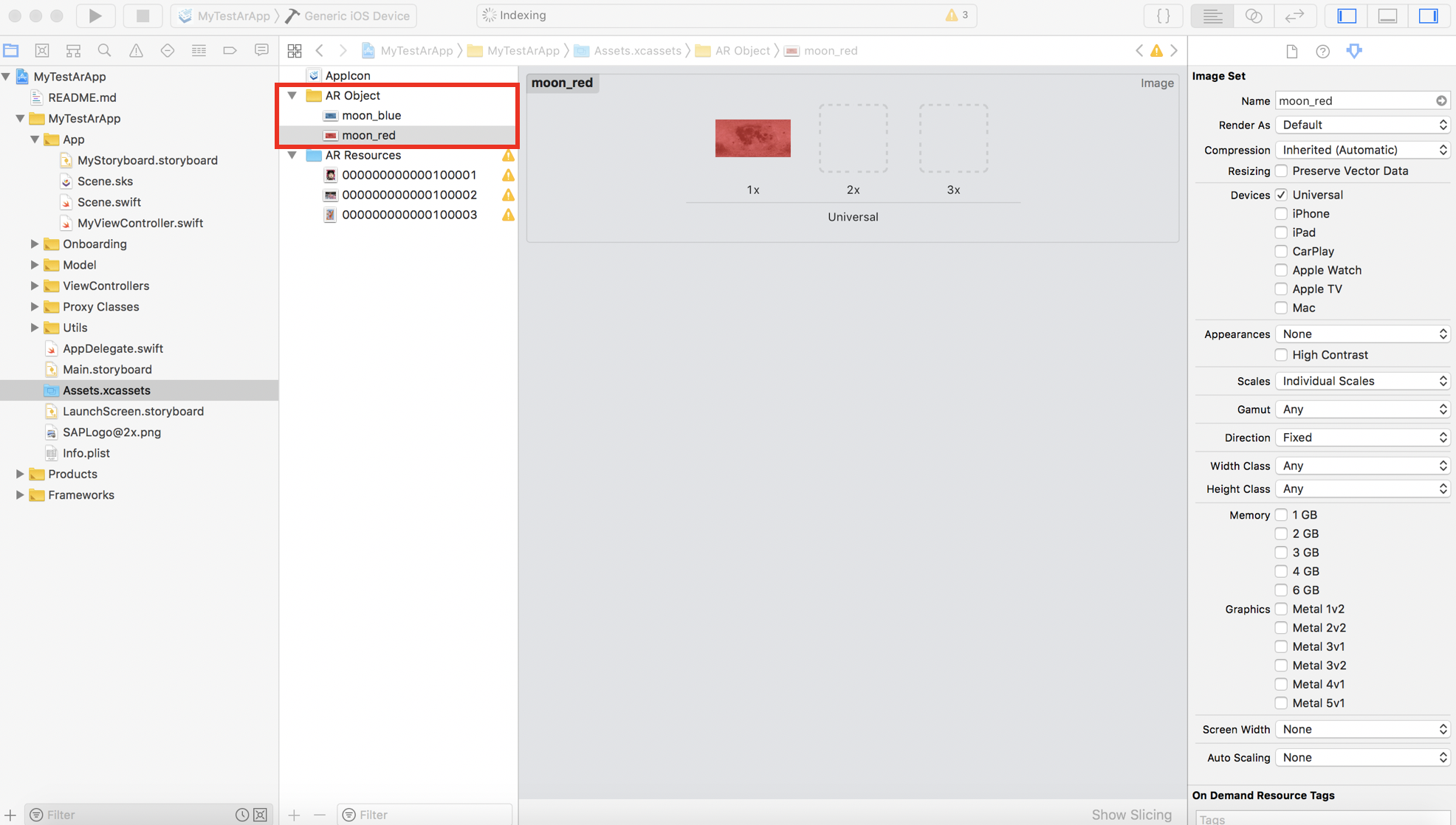
Implement logic at the time of image recognition in delegate method of ARSCNView.
MyViewController.swift
//method:画像認識時の処理
func renderer(_ renderer: SCNSceneRenderer, nodeFor anchor: ARAnchor) -> SCNNode? {
let node = SCNNode()
if let imageAnchor = anchor as? ARImageAnchor {
//ノード作成処理
let markNode = getMoonNode(imageName: imageAnchor.referenceImage.name!)
node.name = imageAnchor.referenceImage.name
node.addChildNode(markNode)
}
return node
}
//method:ノード作成処理
func getMoonNode(imageName: String) -> SCNNode {
// 3Dオブジェクト(球体)の生成
let sphere = SCNSphere(radius: 0.02)
let material = SCNMaterial()
let intStock = stockInfos.filter { $0.matnr == imageName }[0].quan
if (intStock?.intValue())! < 5
{
//店舗在庫の数が5個よりも少なかったら?の球体を生成
material.diffuse.contents = UIImage(named: "moon_red.jpg")
}else{
//店舗在庫の数が5個以上だったら?の球体を生成
material.diffuse.contents = UIImage(named: "moon_blue.jpg")
}
sphere.materials = [material]
let node = SCNNode()
node.position = SCNVector3(0.0, 0.0, 0.03)
node.geometry = sphere
sceneView.scene.rootNode.addChildNode(node)
return node
}
Check
Click the upper left build button to check Xcode project.
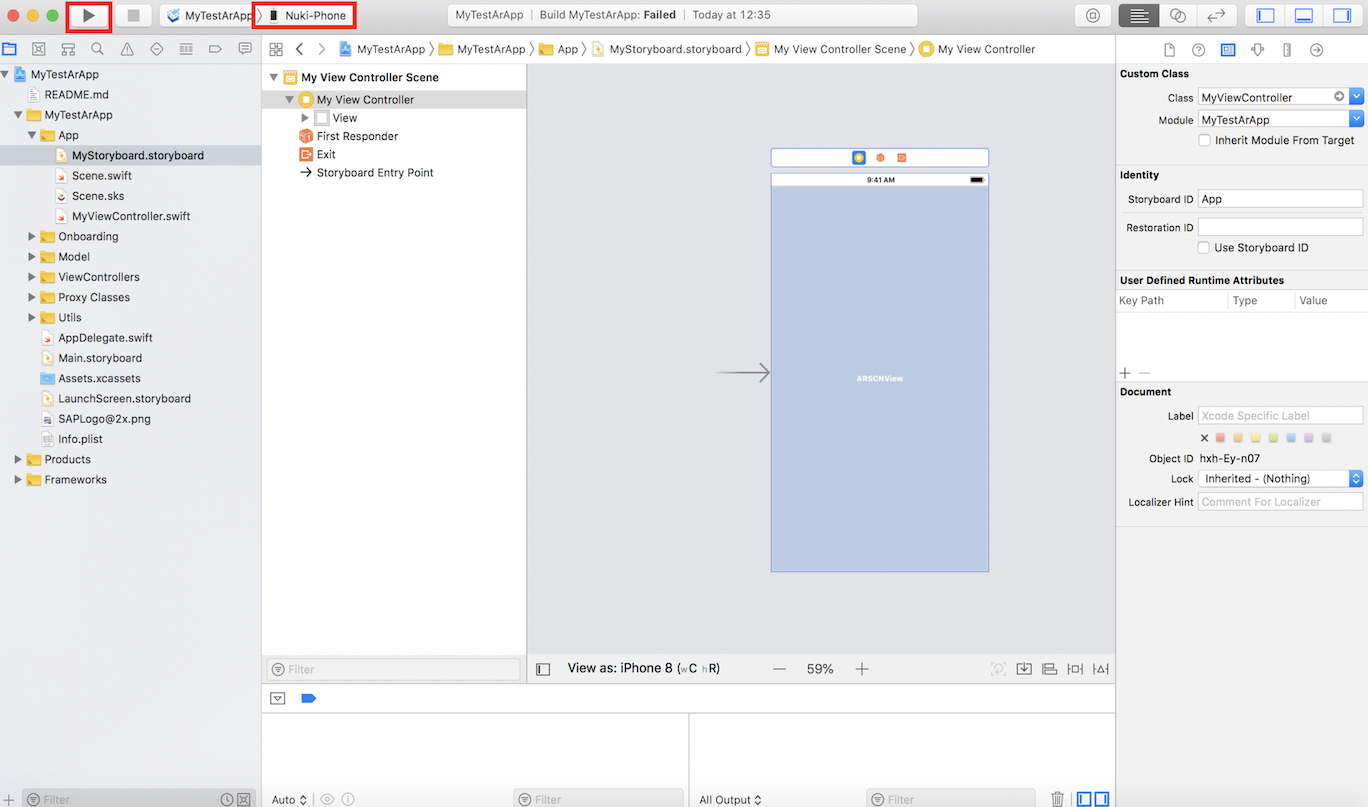
I can confirm the AR object when images is recognized like this.(Using my iPhone)

comparing it with the stock information of S/4HANA, I can confirm that blue spheres are displayed if items are five or more stocks and red balls are displayed if items are fewer than five stocks.

Summary
I created a simple application that displays S/4HANA information in AR using SCP SDK for iOS. By using SDK for iOS, it becomes possible to easily use the latest UI/UX technology of iOS. Mobilization and the accompanying UI/UX transformation are very important factors in promoting digital transformation. It would be interesting to think about what kind of business change AR can be applied to.
- SAP Managed Tags:
- SAP Business Technology Platform
2 Comments
You must be a registered user to add a comment. If you've already registered, sign in. Otherwise, register and sign in.
Labels in this area
-
"automatische backups"
1 -
"regelmäßige sicherung"
1 -
"TypeScript" "Development" "FeedBack"
1 -
505 Technology Updates 53
1 -
ABAP
14 -
ABAP API
1 -
ABAP CDS Views
2 -
ABAP CDS Views - BW Extraction
1 -
ABAP CDS Views - CDC (Change Data Capture)
1 -
ABAP class
2 -
ABAP Cloud
2 -
ABAP Development
5 -
ABAP in Eclipse
1 -
ABAP Platform Trial
1 -
ABAP Programming
2 -
abap technical
1 -
absl
2 -
access data from SAP Datasphere directly from Snowflake
1 -
Access data from SAP datasphere to Qliksense
1 -
Accrual
1 -
action
1 -
adapter modules
1 -
Addon
1 -
Adobe Document Services
1 -
ADS
1 -
ADS Config
1 -
ADS with ABAP
1 -
ADS with Java
1 -
ADT
2 -
Advance Shipping and Receiving
1 -
Advanced Event Mesh
3 -
AEM
1 -
AI
7 -
AI Launchpad
1 -
AI Projects
1 -
AIML
9 -
Alert in Sap analytical cloud
1 -
Amazon S3
1 -
Analytical Dataset
1 -
Analytical Model
1 -
Analytics
1 -
Analyze Workload Data
1 -
annotations
1 -
API
1 -
API and Integration
3 -
API Call
2 -
API security
1 -
Application Architecture
1 -
Application Development
5 -
Application Development for SAP HANA Cloud
3 -
Applications and Business Processes (AP)
1 -
Artificial Intelligence
1 -
Artificial Intelligence (AI)
5 -
Artificial Intelligence (AI) 1 Business Trends 363 Business Trends 8 Digital Transformation with Cloud ERP (DT) 1 Event Information 462 Event Information 15 Expert Insights 114 Expert Insights 76 Life at SAP 418 Life at SAP 1 Product Updates 4
1 -
Artificial Intelligence (AI) blockchain Data & Analytics
1 -
Artificial Intelligence (AI) blockchain Data & Analytics Intelligent Enterprise
1 -
Artificial Intelligence (AI) blockchain Data & Analytics Intelligent Enterprise Oil Gas IoT Exploration Production
1 -
Artificial Intelligence (AI) blockchain Data & Analytics Intelligent Enterprise sustainability responsibility esg social compliance cybersecurity risk
1 -
ASE
1 -
ASR
2 -
ASUG
1 -
Attachments
1 -
Authorisations
1 -
Automating Processes
1 -
Automation
2 -
aws
2 -
Azure
1 -
Azure AI Studio
1 -
Azure API Center
1 -
Azure API Management
1 -
B2B Integration
1 -
Backorder Processing
1 -
Backup
1 -
Backup and Recovery
1 -
Backup schedule
1 -
BADI_MATERIAL_CHECK error message
1 -
Bank
1 -
BAS
1 -
basis
2 -
Basis Monitoring & Tcodes with Key notes
2 -
Batch Management
1 -
BDC
1 -
Best Practice
1 -
bitcoin
1 -
Blockchain
3 -
bodl
1 -
BOP in aATP
1 -
BOP Segments
1 -
BOP Strategies
1 -
BOP Variant
1 -
BPC
1 -
BPC LIVE
1 -
BTP
12 -
BTP Destination
2 -
Business AI
1 -
Business and IT Integration
1 -
Business application stu
1 -
Business Application Studio
1 -
Business Architecture
1 -
Business Communication Services
1 -
Business Continuity
1 -
Business Data Fabric
3 -
Business Partner
12 -
Business Partner Master Data
10 -
Business Technology Platform
2 -
Business Trends
4 -
CA
1 -
calculation view
1 -
CAP
3 -
Capgemini
1 -
CAPM
1 -
Catalyst for Efficiency: Revolutionizing SAP Integration Suite with Artificial Intelligence (AI) and
1 -
CCMS
2 -
CDQ
12 -
CDS
2 -
Cental Finance
1 -
Certificates
1 -
CFL
1 -
Change Management
1 -
chatbot
1 -
chatgpt
3 -
CL_SALV_TABLE
2 -
Class Runner
1 -
Classrunner
1 -
Cloud ALM Monitoring
1 -
Cloud ALM Operations
1 -
cloud connector
1 -
Cloud Extensibility
1 -
Cloud Foundry
4 -
Cloud Integration
6 -
Cloud Platform Integration
2 -
cloudalm
1 -
communication
1 -
Compensation Information Management
1 -
Compensation Management
1 -
Compliance
1 -
Compound Employee API
1 -
Configuration
1 -
Connectors
1 -
Consolidation Extension for SAP Analytics Cloud
2 -
Control Indicators.
1 -
Controller-Service-Repository pattern
1 -
Conversion
1 -
Cosine similarity
1 -
cryptocurrency
1 -
CSI
1 -
ctms
1 -
Custom chatbot
3 -
Custom Destination Service
1 -
custom fields
1 -
Customer Experience
1 -
Customer Journey
1 -
Customizing
1 -
cyber security
3 -
cybersecurity
1 -
Data
1 -
Data & Analytics
1 -
Data Aging
1 -
Data Analytics
2 -
Data and Analytics (DA)
1 -
Data Archiving
1 -
Data Back-up
1 -
Data Flow
1 -
Data Governance
5 -
Data Integration
2 -
Data Quality
12 -
Data Quality Management
12 -
Data Synchronization
1 -
data transfer
1 -
Data Unleashed
1 -
Data Value
8 -
database tables
1 -
Datasphere
3 -
datenbanksicherung
1 -
dba cockpit
1 -
dbacockpit
1 -
Debugging
2 -
Defender
1 -
Delimiting Pay Components
1 -
Delta Integrations
1 -
Destination
3 -
Destination Service
1 -
Developer extensibility
1 -
Developing with SAP Integration Suite
1 -
Devops
1 -
digital transformation
1 -
Documentation
1 -
Dot Product
1 -
DQM
1 -
dump database
1 -
dump transaction
1 -
e-Invoice
1 -
E4H Conversion
1 -
Eclipse ADT ABAP Development Tools
2 -
edoc
1 -
edocument
1 -
ELA
1 -
Embedded Consolidation
1 -
Embedding
1 -
Embeddings
1 -
Employee Central
1 -
Employee Central Payroll
1 -
Employee Central Time Off
1 -
Employee Information
1 -
Employee Rehires
1 -
Enable Now
1 -
Enable now manager
1 -
endpoint
1 -
Enhancement Request
1 -
Enterprise Architecture
1 -
ETL Business Analytics with SAP Signavio
1 -
Euclidean distance
1 -
Event Dates
1 -
Event Driven Architecture
1 -
Event Mesh
2 -
Event Reason
1 -
EventBasedIntegration
1 -
EWM
1 -
EWM Outbound configuration
1 -
EWM-TM-Integration
1 -
Existing Event Changes
1 -
Expand
1 -
Expert
2 -
Expert Insights
2 -
Exploits
1 -
Fiori
14 -
Fiori Elements
2 -
Fiori SAPUI5
12 -
Flask
1 -
Full Stack
8 -
Funds Management
1 -
General
1 -
General Splitter
1 -
Generative AI
1 -
Getting Started
1 -
GitHub
8 -
Grants Management
1 -
GraphQL
1 -
groovy
1 -
GTP
1 -
HANA
6 -
HANA Cloud
2 -
Hana Cloud Database Integration
2 -
HANA DB
2 -
HANA XS Advanced
1 -
Historical Events
1 -
home labs
1 -
HowTo
1 -
HR Data Management
1 -
html5
8 -
HTML5 Application
1 -
Identity cards validation
1 -
idm
1 -
Implementation
1 -
input parameter
1 -
instant payments
1 -
Integration
3 -
Integration Advisor
1 -
Integration Architecture
1 -
Integration Center
1 -
Integration Suite
1 -
intelligent enterprise
1 -
iot
1 -
Java
1 -
job
1 -
Job Information Changes
1 -
Job-Related Events
1 -
Job_Event_Information
1 -
joule
4 -
Journal Entries
1 -
Just Ask
1 -
Kerberos for ABAP
8 -
Kerberos for JAVA
8 -
KNN
1 -
Launch Wizard
1 -
Learning Content
2 -
Life at SAP
5 -
lightning
1 -
Linear Regression SAP HANA Cloud
1 -
Loading Indicator
1 -
local tax regulations
1 -
LP
1 -
Machine Learning
2 -
Marketing
1 -
Master Data
3 -
Master Data Management
14 -
Maxdb
2 -
MDG
1 -
MDGM
1 -
MDM
1 -
Message box.
1 -
Messages on RF Device
1 -
Microservices Architecture
1 -
Microsoft Universal Print
1 -
Middleware Solutions
1 -
Migration
5 -
ML Model Development
1 -
Modeling in SAP HANA Cloud
8 -
Monitoring
3 -
MTA
1 -
Multi-Record Scenarios
1 -
Multiple Event Triggers
1 -
Myself Transformation
1 -
Neo
1 -
New Event Creation
1 -
New Feature
1 -
Newcomer
1 -
NodeJS
2 -
ODATA
2 -
OData APIs
1 -
odatav2
1 -
ODATAV4
1 -
ODBC
1 -
ODBC Connection
1 -
Onpremise
1 -
open source
2 -
OpenAI API
1 -
Oracle
1 -
PaPM
1 -
PaPM Dynamic Data Copy through Writer function
1 -
PaPM Remote Call
1 -
PAS-C01
1 -
Pay Component Management
1 -
PGP
1 -
Pickle
1 -
PLANNING ARCHITECTURE
1 -
Popup in Sap analytical cloud
1 -
PostgrSQL
1 -
POSTMAN
1 -
Process Automation
2 -
Product Updates
4 -
PSM
1 -
Public Cloud
1 -
Python
4 -
python library - Document information extraction service
1 -
Qlik
1 -
Qualtrics
1 -
RAP
3 -
RAP BO
2 -
Record Deletion
1 -
Recovery
1 -
recurring payments
1 -
redeply
1 -
Release
1 -
Remote Consumption Model
1 -
Replication Flows
1 -
research
1 -
Resilience
1 -
REST
1 -
REST API
2 -
Retagging Required
1 -
Risk
1 -
Rolling Kernel Switch
1 -
route
1 -
rules
1 -
S4 HANA
1 -
S4 HANA Cloud
1 -
S4 HANA On-Premise
1 -
S4HANA
3 -
S4HANA_OP_2023
2 -
SAC
10 -
SAC PLANNING
9 -
SAP
4 -
SAP ABAP
1 -
SAP Advanced Event Mesh
1 -
SAP AI Core
8 -
SAP AI Launchpad
8 -
SAP Analytic Cloud Compass
1 -
Sap Analytical Cloud
1 -
SAP Analytics Cloud
4 -
SAP Analytics Cloud for Consolidation
3 -
SAP Analytics Cloud Story
1 -
SAP analytics clouds
1 -
SAP API Management
1 -
SAP BAS
1 -
SAP Basis
6 -
SAP BODS
1 -
SAP BODS certification.
1 -
SAP BTP
21 -
SAP BTP Build Work Zone
2 -
SAP BTP Cloud Foundry
6 -
SAP BTP Costing
1 -
SAP BTP CTMS
1 -
SAP BTP Innovation
1 -
SAP BTP Migration Tool
1 -
SAP BTP SDK IOS
1 -
SAP Build
11 -
SAP Build App
1 -
SAP Build apps
1 -
SAP Build CodeJam
1 -
SAP Build Process Automation
3 -
SAP Build work zone
10 -
SAP Business Objects Platform
1 -
SAP Business Technology
2 -
SAP Business Technology Platform (XP)
1 -
sap bw
1 -
SAP CAP
2 -
SAP CDC
1 -
SAP CDP
1 -
SAP CDS VIEW
1 -
SAP Certification
1 -
SAP Cloud ALM
4 -
SAP Cloud Application Programming Model
1 -
SAP Cloud Integration for Data Services
1 -
SAP cloud platform
8 -
SAP Companion
1 -
SAP CPI
3 -
SAP CPI (Cloud Platform Integration)
2 -
SAP CPI Discover tab
1 -
sap credential store
1 -
SAP Customer Data Cloud
1 -
SAP Customer Data Platform
1 -
SAP Data Intelligence
1 -
SAP Data Migration in Retail Industry
1 -
SAP Data Services
1 -
SAP DATABASE
1 -
SAP Dataspher to Non SAP BI tools
1 -
SAP Datasphere
9 -
SAP DRC
1 -
SAP EWM
1 -
SAP Fiori
3 -
SAP Fiori App Embedding
1 -
Sap Fiori Extension Project Using BAS
1 -
SAP GRC
1 -
SAP HANA
1 -
SAP HCM (Human Capital Management)
1 -
SAP HR Solutions
1 -
SAP IDM
1 -
SAP Integration Suite
9 -
SAP Integrations
4 -
SAP iRPA
2 -
SAP LAGGING AND SLOW
1 -
SAP Learning Class
1 -
SAP Learning Hub
1 -
SAP Master Data
1 -
SAP Odata
2 -
SAP on Azure
2 -
SAP PartnerEdge
1 -
sap partners
1 -
SAP Password Reset
1 -
SAP PO Migration
1 -
SAP Prepackaged Content
1 -
SAP Process Automation
2 -
SAP Process Integration
2 -
SAP Process Orchestration
1 -
SAP S4HANA
2 -
SAP S4HANA Cloud
1 -
SAP S4HANA Cloud for Finance
1 -
SAP S4HANA Cloud private edition
1 -
SAP Sandbox
1 -
SAP STMS
1 -
SAP successfactors
3 -
SAP SuccessFactors HXM Core
1 -
SAP Time
1 -
SAP TM
2 -
SAP Trading Partner Management
1 -
SAP UI5
1 -
SAP Upgrade
1 -
SAP Utilities
1 -
SAP-GUI
8 -
SAP_COM_0276
1 -
SAPBTP
1 -
SAPCPI
1 -
SAPEWM
1 -
sapmentors
1 -
saponaws
2 -
SAPS4HANA
1 -
SAPUI5
5 -
schedule
1 -
Script Operator
1 -
Secure Login Client Setup
8 -
security
9 -
Selenium Testing
1 -
Self Transformation
1 -
Self-Transformation
1 -
SEN
1 -
SEN Manager
1 -
service
1 -
SET_CELL_TYPE
1 -
SET_CELL_TYPE_COLUMN
1 -
SFTP scenario
2 -
Simplex
1 -
Single Sign On
8 -
Singlesource
1 -
SKLearn
1 -
Slow loading
1 -
soap
1 -
Software Development
1 -
SOLMAN
1 -
solman 7.2
2 -
Solution Manager
3 -
sp_dumpdb
1 -
sp_dumptrans
1 -
SQL
1 -
sql script
1 -
SSL
8 -
SSO
8 -
Substring function
1 -
SuccessFactors
1 -
SuccessFactors Platform
1 -
SuccessFactors Time Tracking
1 -
Sybase
1 -
system copy method
1 -
System owner
1 -
Table splitting
1 -
Tax Integration
1 -
Technical article
1 -
Technical articles
1 -
Technology Updates
14 -
Technology Updates
1 -
Technology_Updates
1 -
terraform
1 -
Threats
2 -
Time Collectors
1 -
Time Off
2 -
Time Sheet
1 -
Time Sheet SAP SuccessFactors Time Tracking
1 -
Tips and tricks
2 -
toggle button
1 -
Tools
1 -
Trainings & Certifications
1 -
Transformation Flow
1 -
Transport in SAP BODS
1 -
Transport Management
1 -
TypeScript
2 -
ui designer
1 -
unbind
1 -
Unified Customer Profile
1 -
UPB
1 -
Use of Parameters for Data Copy in PaPM
1 -
User Unlock
1 -
VA02
1 -
Validations
1 -
Vector Database
2 -
Vector Engine
1 -
Visual Studio Code
1 -
VSCode
1 -
Vulnerabilities
1 -
Web SDK
1 -
work zone
1 -
workload
1 -
xsa
1 -
XSA Refresh
1
- « Previous
- Next »
Related Content
- Displaying total at the end of table in SAP CAP BTP object page in Technology Q&A
- Easy way to find S4HANA CDS views for Functional Consultants!! in Technology Blogs by Members
- Streamlining Time Sheet Approvals in SuccessFactors: Time Sheet Approval Center in Technology Blogs by Members
- Developer extendibility for custom table and publish oDATA in Technology Q&A
- What’s New in SAP Datasphere Version 2024.8 — Apr 11, 2024 in Technology Blogs by Members
Top kudoed authors
| User | Count |
|---|---|
| 8 | |
| 5 | |
| 5 | |
| 4 | |
| 4 | |
| 4 | |
| 4 | |
| 3 | |
| 3 | |
| 3 |